In This Issue :
- The Best Program
- Check Yearly. See Clearly.
- Eye America®
- Resources
- EyeSite Tours the Country
- Reports From NEHEP Work Groups
- Innovative Outreach on Low Vision
- Lorraine H. Marchi Receives Honorary Degree from SUNY
- Low Vision Materials Available in Spanish
- Free Eye Health Care Service Delivered by ChildSight®'s Mobile EyeCare Unit
- Nationwide Consortium Efforts
- Watch for Healthy Vision Month in May 2003
Looking Back...Looking Forward
The NEHEP Partnership
The power of partnership--a multitude collaborating as one--is the secret of the unique success of the National Eye Health Education Program (NEHEP) Partnership. For more than 10 years, the NEHEP Partnership has informed Americans about good eye health practices like regular comprehensive exams, which help detect eye diseases in their early stages.
Formed in 1989 with 35 organizations, the Partnership has grown into a collaboration of more than 60 public and private organizations at the national level, including professional associations, voluntary health organizations, civic and fraternal organizations, and government agencies, that have an interest in eye health education.
Members of the Partnership have successfully taken eye health messages formulated at the national level to their members and affiliates, which deliver them to places like schools, faith institutions, clinics, older adult groups, and community centers across the country. There, people like organization members, community leaders, health professionals, or patients themselves may promote good vision care by distributing information, hosting health fairs, or leading discussions on the importance of early detection.
"The NEHEP Program represents an outstanding example of a public- private partnership where resources are shared and not duplicated," said National Eye Institute (NEI) Director Paul A. Sieving, M.D., Ph.D."Local affiliates and programs can direct their resources toward what they do best-provide services and promote education."
The Partnership's 10 years of growth and success are documented in an extensive report that marks the group's anniversary. The report provides an overview of the strengths and challenges of a group of individual organizations that has thrived for a decade in laying the foundation to preserve the Nation's vision and improve the lives of millions of Americans.
Norma Boyer, O.D., M.P.H., F.A.A.O., said that the NEHEP Partnership has "helped place vision and eye care services on the forefront of the Nation's public health agenda." Dr. Boyer is a member of the NEHEP Planning Committee and representative to the American Optometric Association.
"The Partnership has played an invaluable role in raising national awareness--with the public, practitioners, and policymakers--about the importance of primary eye care and vision services in assuring quality of life for Americans of all ages, cultural and ethnic groups, and socio-economic levels," Dr. Boyer said.
Partnership That Works
NEHEP Partnership Awardees
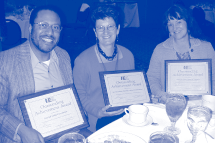
Lenworth Johnson, Ph.D., (left) accepts the
award on behalf of the National Medical
Association. Fran Jacobson (middle) accepts
the award on behalf of the Juvenile Diabetes
Research Foundation International. Lenyra M.
DeBruyn, Ph.D., (right) accepts the award on
behalf of the Centers for Disease Control and
Prevention, U.S. Public Health Service.
Key findings in the NEHEP 10-Year Process Evaluation Report suggest that most Partners agree that the NEHEP has increased their organizations' capacity to serve and inform their audience, which the report notes is the "ultimate beneficiary of NEHEP services and the driving force behind its creation."
Most Partners observed that their audiences--primarily eye care professionals, people at high risk, minority populations, and the general public--received NEHEP messages. NEHEP efforts have included the development and dissemination of thousands of educational kits, press releases, and public service announcements on glaucoma, diabetic eye disease, and low vision.
According to the report, most Partners believe that NEHEP-provided information increased the audience's knowledge about early detection and the prevention of eye disease. Partners gauged the increase through feedback from the audience itself, conversations with eye health professionals, and systematic, objective surveys, all which demonstrated that the messages were delivered successfully to their targets.
"When a person's eyesight is saved, there is a tremendous improvement in that person's quality of life," NEHEP Partner Lenworth N. Johnson, M.D., said recently. Dr. Johnson is the NEHEP representative from the National Medical Association.
"Consider the effect of saving thousands of individuals' eyesight," Dr. Johnson said. "The NEHEP Partnership is playing that vital role of moving the Nation toward that goal."
Moreover, Partners agreed that the power of the collective group is stronger than each individual organization, that partnering works. Most Partners believed that their organization has benefited from associating with NEHEP and the NEI, that the Partnership has been responsive to their organization's needs, that each Partner was capable of working toward "collaborative empowerment," and that their group would recommend becoming a NEHEP Partner to others.
"Partnering with NEHEP has provided a productive forum for us and other eye health organizations to exchange ideas, learn from one another, and coordinate efforts," said H. Dunbar Hoskins, Jr., M.D., NEHEP Partner and Executive Vice President of the American Academy of Ophthalmology.
NEHEP Partners interviewed for the report said that the benefits of working together included information exchange, the avoidance of effort duplication, and the creation of "a critical mass or synergy," where the whole is greater than its parts.
The 10-year report looked at the Partnership's effectiveness across three areas: glaucoma, diabetic eye disease, and low vision. Topics explored included the benefits and barriers to Partnership, the perceived role of Partners, and Partners' awareness and attitudes toward NEHEP. The authors of the report interviewed a variety of executives and representatives of Partner organizations, from front-line staff to mid-level managers to executives. Most Partner organizations employed fewer than 25 people and focused on low vision, diabetic eye disease, glaucoma, or all three.
"The information collected will be used as a guide to develop new programs and strategies," said Rosemary Janiszewski, NEHEP Director. "It will help strengthen the role of the NEHEP Partnership."
Strengthening the Partnership
One way to strengthen the NEHEP Partnership that emerged from the report was the continued enhancement of partner-to-partner collaboration. Lack of time was the most frequently mentioned challenge of working together with other NEHEP Partners, followed by differing priorities and interests, lack of communication, and limited organizational resources.

Another theme for strengthening the Partnership was improving communication among Partners and the NEI through e-mail, Web sites, and Listservs. NEHEP Partners also suggested conducting more meetings, developing additional effective ways to communicate, and using the media. Other suggestions included exchanging information about each Partner's activities and "bringing together Partners with similar interests to find common ground."
The report encourages partnering as both the cornerstone and building blocks of the organization: two-thirds of Partners "want more collaboration between partners." Evaluators recommended that more information about each Partner and its activities be provided to the group at large and that NEHEP look closely at the needs and challenges of several NEHEP founding Partners. They also suggested strengthening the identity between Partners and NEHEP, which may lead to "long-term benefits of a stronger and more cohesive organization."
The primary NEHEP audience--Americans at risk of blindness or visual impairment--is expected to multiply in the coming decade as the "baby boomer" generation ages, according to NEI's Dr. Sieving.
"Expanded public and professional education efforts are essential to accomplish the goal of preserving our vision," said Dr. Sieving. "We need to be sensitive to differences in age and gender, ethnicity, and economic status. We need to do an even better job of reaching people at risk in their neighborhoods, schools, faith communites, and worksites through the media. Healthy vision is a shared responsibility among all of us in the government, as health care providers, community leaders, patients, and private citizens."
The report also included an in-depth analysis of print and media coverage of NEHEP's program areas. For a complete NEHEP 10-Year Process Evaluation Report, visit http://www.nei.nih.gov/nehep/docs/10yearprocessrval.pdf.*PDF
The BEST Program
"The Texas Commission for the Blind envisions a state where all Texans will be educated about the preventable causes of blindness and will recognize the risk factors for vision loss in themselves and in their families. Routine access to vision screenings will be available to all Texans regardless of their financial resources. With available resources, Texans with a treatable eye disease will have access to timely treatment." --BEST Program Vision Statement.
To achieve that vision, the Texas Commission for the Blind (TCB) developed a program to provide education, vision screenings, and treatment to Texas residents. The blindness education, screening, and treatment (BEST) program was created to promote healthy vision to adult Texans without health insurance who have an urgent medical necessity for eye disease treatment.
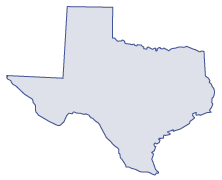
BEST has three components:
Blindness education is provided on the preventable causes of blindness, with an emphasis on glaucoma and diabetic retinopathy. TCB uses broadcast public service announcements, brochures, a media campaign, and other collateral materials to disseminate the core message for adult Texans to receive annual eye examinations.
Free non-diagnostic vision screenings are available to adult Texas residents through contracts with Prevent Blindness Texas. With steady growth, the screening program is expected to have statewide coverage within five years.
Eye medical treatment is available to adult Texans who lack health insurance. TCB pays for treatment of conditions that can cause vision loss, including glaucoma, diabetic retinopathy, detached retina, or other eye diseases that pose an urgent medical necessity.
The BEST program is funded by the generosity of Texans who volunteer to donate $1 when renewing their driver's licenses or state identification cards. Services are provided within the limitation of available program funds, but TCB maintains a waiting list when treatment needs exceed available resources.
For more information, please contact BEST toll-free at 1-877-NO SPARE (1-877-667-7273) or Ron Lucey at 512-377-0577 or ron.lucey@tcb.state.tx.us.
Check Yearly. See Clearly.
Taking a lesson from the dental industry, the Vision Council of America has started a nationwide initiative to encourage more people to schedule regular eye exams. Launched last fall, VCA's "Check Yearly. See Clearly." campaign hopes to raise vision health awareness across the country.
"It's common sense to have your teeth checked every six months," said Rob Philips, Manager of Professional and Consumer Relations at VCA. "People may go years or decades without having an eye exam." The campaign aims to change this pattern of neglect through an ambitious eye-health awareness blitz. Materials include brochures, stickers, magnets, buttons, pencils, wall clocks, window decals, and checkup recall cards.
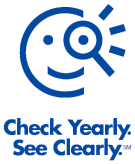
More than 3,000 opticians, optometrists, and ophthalmologists are already participating in the campaign, Philips said. VCA now hopes to spread the materials--at or below costs--to the other 30,000 to 40,000 eye doctors nationwide.
"The aim is to provide a clear, consistent message across the country," Philips said, adding that many doctors already distribute their own eye-health literature, but often in a piecemeal fashion. To help foster a consistent message, "Check Yearly. See Clearly." materials come branded with a recognizable smiley logo.
"The whole idea of the campaign is to turn your waiting room into a classroom … get the materials into the patients' hands," said eye care professional John Warren, who has been distributing VCA materials in his Racine, Wisconsin, office for the past two months.
"The patients are there for a reason, they're a receptive audience," he said. The patients will then go out and spread the message about the importance of regular eye exams to their family and friends, Warren noted.
Still, the waiting-room materials are just one phase of the campaign. VCA is also launching a media blitz to try and place stories on the importance of eye care in newspapers and on television. VCA is also developing customizable advertisements, which are available to doctors for no charge. The doctors can then purchase advertising space together and list their contact information at the bottom of the ad. Furthermore, the "Check Yearly. See Clearly." website--www.checkyearly.com--offers a self-test so people can determine if it is time for them or a member of their family to schedule an eye exam.
This strategy has earned the support of the American Optometric Association, Opticians Association of America, International Eye Foundation, and many other vision- and health-related organizations. The dental industry has done a great job of improving general dental care over the years, said Warren. Unfortunately, "the percentage of people who understand or know they should have routine eye exams is pretty grim," he said. "This is a good first step." For more information, please contact Rob Philips at 703-548-4560 or www.checkclearly.com.
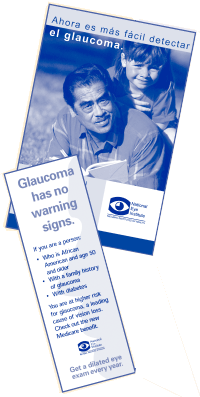
Medicare covers an annual dilated eye examination for all people at high risk for glaucoma. This important new preventive benefit will safeguard the vision of millions of Americans enrolled in the Medicare program.
The new benefit defines high-risk populations as those with diabetes; those with a family history of glaucoma; and African Americans aged 50 and older. Glaucoma is five times more likely to occur in African Americans than in whites and about four times more likely to cause blindness in African Americans than in whites.
To educate people with Medicare about the new glaucoma benefit, a bookmark in English and a health fair card in Spanish are available. These materials can be used in a variety of ways such as vision screening events, libraries, and mobile health vans. These materials also contain information about referral programs sponsored by the American Academy of Ophthalmology and the American Optometric Association.
To order free quantities, contact the National Eye Institute:
Glaucoma
2020 Vision Place
Bethesda, MD 20892-3655
800-869-2020
www.nei.nih.gov
EyeCare America®
The Foundation of the American Academy of Ophthalmology has undergone an extensive branding process and announced this month its new look and identity. Now known as EyeCare America®, its mission, and specifically that of its public service programs, is still to reduce avoidable blindness, provide education, and facilitate eye care for the public. Its mission complements the Vision and Hearing Focus Area of Healthy People 2010, which strives to "improve the visual and hearing health of the Nation through prevention, early detection, treatment, and rehabilitation."

In a single year, crucial EyeCare America public service messages have reached more than 100 million people, but there are still millions more at risk of needless avoidable blindness. "Our public service programs are more critical now than ever, especially with our rapidly aging population," said Dr. B. Thomas Hutchinson, chair of EyeCare America's public service programs. "We have a dedicated group of volunteers eager to put their profession to use saving sight or restoring quality vision. The real challenge is spreading our message so folks in need can take advantage of the information and services available. With more than 7,000 volunteer ophthalmologists across the country, we are ready to serve different populations through specialized programs." Now in its third decade of service, EyeCare America's public service programs target various populations at risk for eye disease through four national programs:
The Seniors EyeCare Program, formerly ECA-National Eye Care Project (NECP), strives to prevent blindness among older Americans by increasing their awareness of the importance of regular medical eye care and helping them gain access to treatment. Since its inception, Seniors EyeCare has helped more than 600,000 older Americans, and volunteer ophthalmologists have detected more than 100,000 cases of eye disease. Older adults can call the toll-free, 24-hour-a-day, seven-day-a-week helpline at 800-222-EYES (3937). Those who qualify for treatment are matched with a nearby volunteer ophthalmologist for an eye examination and up to one year of treatment for any condition diagnosed at the initial visit at no out-of-pocket expense to the patient.
The Diabetes EyeCare Program, also known as the Diabetes Project's Diabetes Eye Exam Initiative, is a partnership between EyeCare America and the Centers for Medicare and Medicaid Services (CMS) (formerly Health Care Finance Administration) and marks the first time that CMS and a medical society have joined together on a nationwide health care improvement project. The Diabetes EyeCare Program and Diabetes Eye Exam Initiative work to ensure that all Americans with diabetes who have not sought regular eye care are aware of their increased risk for eye disease. The program targets all known Medicare beneficiaries with diabetes by sending 600,000 copies of a direct mail piece highlighting their increased risk for eye disease. Recipients are encouraged to call the toll-free, 24-hour-a-day, seven-day-a-week helpline at 800-628-6733 to determine if they qualify for eye care and treatment at no out-of-pocket cost to them.
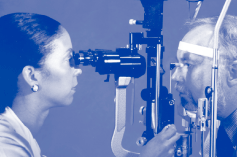
The Glaucoma EyeCare Program, formerly the ECA-Glaucoma Project, is the newest of the Academy's outreach efforts. Currently being piloted in Massachusetts and Virginia, the program raises awareness about glaucoma among those with high-risk factors, including people with a family history of glaucoma, African Americans, and older adults. Individuals who call the toll-free, 24-hour-a-day, seven-day-a-week helpline at 800-391-EYES (3937) are screened for evidence-based risk factors. Plans for the project include nationwide expansion following the pilot phase. Currently in the developmental stages, the Children's EyeCare Program enhances existing child referral systems. Children's EyeCare literature describes common childhood eye problems and encourages parents or caregivers of children with any of the symptoms to take their child to their family physician. The physician then can determine if the child needs further examination and care, and make the appropriate referral.
For more information, please contact Blake Marler at EyeCare America at 415-561-8518 or bmarler@aao.org.
Resources
The American Foundation for the Blind, a member of the National Eye Health Education Program Partnership, has developed resources for caregivers of older adults. Solutions for Everyday Living for Older People With Visual Impairments is a video that shows how staff members in continuing care communities and assisted living settings for older people can help residents function as independently as possible.

Solutions for Success: A Training Manual for Working With Older People Who Are Visually Impaired is a new curriculum intended to help caregivers recognize vision loss and to provide valuable information and techniques for ensuring that older individuals live as independently and safely as possible.
EYE SITE Tours the Country
A Traveling Exhibit on Low Vision for Shopping Centers
THE EYE SITE features an interactive multimedia touchscreen program; provides information on low vision materials and local services and resources; and displays aids and devices that help people with low vision live full lives.
The exhibit includes five colorful kiosks and is designed to attract a cross-section of the population, from the young to senior citizens. The exhibit tour was launched in April 2001 in Los Angeles. By the end of 2002, two identical exhibits will have visited 32 malls in 14 states.
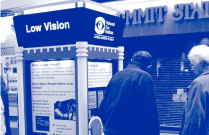
October 3-31
Glendale Mall
Indianapolis, Indiana
November 2-18
Concord Mall
Elkhart, Indiana
July 13-27
Union Station (West Hall)
Washington, DC
(other sites in DC pending)
Colorado--Planning underway
Pennsylvania--Planning underway
For more information, visit at www.nei.nih.gov/nehep/eyesite.
Contact: Jean Horrigan, 301-496-5248.
Reports from NEHEP Work Groups on . . .
Hispanic Outreach
"¿Cuando fue la Última vez que se hizo un examen de los ojos?" (When was the last time you had your eyes examined?)--That's the message of a new eye health awareness campaign for Hispanic audiences. The NEHEP Working Group on Hispanic Outreach is concerned with increasing the Hispanic community's awareness about eye health. The emphasis is on the need for early detection and timely treatment of glaucoma and diabetic eye disease, the availability of rehabilitative services for low vision, and the availability of Medicare benefits related to the early detection of glaucoma. The ¡Ojo Con Su Visión! (Watch out for your Vision!) Program has been popular in educating Hispanics with diabetes on the importance of getting an annual dilated eye exam, but the new campaign takes a broader approach reaching out to the entire Hispanic community at risk for certain eye diseases.

As part of the development of the new campaign, a one-day Work Group Meeting on Hispanic Outreach was convened in March 2002 to review program materials and activities. Leading eye health professionals, communicators, and representatives of Hispanic health organizations identified new resources and communication channels to reach the target audience.
This spring, focus groups were held in Washington, DC, and in Milwaukee, Wisconsin, to learn how Hispanics perceive eye health. Key findings of the groups include recognition of the importance of eye health and getting eye exams, belief that poor vision can drastically impede their lives, and confirmation that television is the most popular venue for receiving health-related information. As a result of the focus group findings and input from Work Group members, a new Spanish-language eye health brochure and television public service announcement are in progress.
Moving forward, a two-tiered approach is being tested that includes a community-based test-market site model and a national promotion and dissemination model in Milwaukee, Orlando, and San Antonio. Karen Silver, NEHEP Health Education Coordinator, remarked that with this approach, "the NEI is seeking greater understanding of best practices of dissemination strategies at the community level." Best practices and dissemination strategies collected from these test-market sites will help NEHEP apply lessons learned to a national dissemination effort.
The Work Group Meeting on Hispanic Outreach Summary Report is available online at http://www.nei.nih.gov/nehep/docs/marchmeeting.pdf.*PDF Focus group findings are available online at http://www.nei.nih.gov/nehep/docs/hispaniceyehealth.pdf. *PDF
American Indian and Alaska Native Outreach
Diabetes affects more than 12 percent of American Indians and Alaska Natives aged 19 and older and is the sixth leading cause of death. High rates of diabetes put these populations at greater risk for diabetic eye diseases, but there is a deficit of data and strategic outreach for improving their eye care.
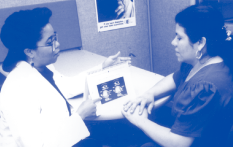
NEHEP staff began to develop outreach and communications strategies for the American Indian and Alaska Native populations in summer 2001. Staff conducted an environmental scan of the vision-related programs and services provided to American Indians and Alaska Natives to identify gaps in eye health information, services, programs, and materials targeted to these groups. In June 2002, a one-day Work Group Meeting on American Indian and Alaska Native Outreach was convened with members of leading American Indian and Alaska Native national and community-based organizations, NEHEP partners, and health care providers.
Karen Silver, NEHEP Health Education Coordinator, noted that with this gathering, "the NEI is pleased to be embarking for the first time on an outreach effort focused specifically on American Indians and Alaska Natives, and we look forward to a sustained relationship to improve the eye health of these communities."
This group provided advice on activities to raise awareness of diabetic eye disease among American Indians and Alaska Natives and identified communication channels that can be used to develop a national eye health awareness program for these populations. Moving forward, NEHEP in collaboration with Work Group members will craft a communication plan on diabetic eye disease for reaching American Indian and Alaska Native populations.
The Work Group Meeting on American Indian and Alaska Native Summary Report will soon be available on the NEI Website.
Innovative Outreach on Low Vision
National Association for Visually Handicapped (NAVH) offers, for nationwide replication, its innovative "SightMobile for Seniors Outreach Program." For nearly half a century, NAVH remains the only voluntary national health agency that serves the partially seeing, exclusively. Its mission is to promote the active use of remaining eyesight among the "hard of seeing," so that such residual vision is not lost for lack of use. Maintaining usable vision is what NAVH is all about.

Education is crucial. Despite burgeoning numbers afflicted with-most often, age-related-vision loss, too few are aware of the many services available that enable the pursuit and continuance of independence and productivity in a fully sighted world. Outreach is essential. Many--especially seniors confronted with diminishing eyesight in their "golden years"--tend to deny the problem out of fear and embarrassment, even shame and guilt. They are frustrated and frightened by not being able to do what they once did. Forced dependence upon family and/or community looms. Self-imposed isolation is common.
In operation for three years, the SightMobile Program serves the needs of low vision seniors in greater New York. Building upon the success of its Low Vision Resource Centers Program which currently involves 23 installations nationally, NAVH took the next step toward increasing access to its services for visually impaired seniors in the New York area, many of whom are unable to fully take advantage of sorely needed vision services because of limited means and the inability to use public transportation.
The availability of the Program is publicized through print and electronic media; liaison with Program Directors of senior centers, senior residences, libraries offering seniors programs, nursing homes, and rehabilitation hospitals; as well as consistent distribution of flyers at health fairs and promotional exhibits. The SightMobile travels throughout targeted areas, to pre-arranged locations at appointed times.
We bring the people to NAVH. With the help of a generous grant from the Reader's Digest Partners for Sight Foundation, NAVH has been able to purchase a 24-passenger, wheelchair accessible bus to transport low- income, visually-impaired seniors from underserved communities to NAVH headquarters. There, they test and are counseled in the use of a wide array of magnifying devices and special lighting; browse and make selections from our free-by-mail large print loan library; investigate low vision computer access technology; learn about vision and vision loss; and derive emotional support from peers and trained NAVH staff.
We bring NAVH to the people. When circumstances warrant, the SightMobile leaves headquarters equipped with visual aids, including a closed circuit TV read/write machine, low-vision lighting, and large-print materials. NAVH staff, assigned to each "outing," are prepared to offer information and advice on vision issues, counseling and guidance in the testing and use of helpful devices, referrals to eye care professionals and service agencies, and advocacy on behalf of entitlements for those with vision loss.
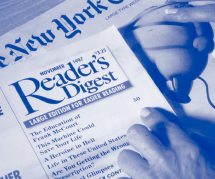
An urgent issue for many seniors--especially those with physical and mental limitations--is to have helping services brought into the home when circumstances prevent access to programs outside, and even within, the community. NAVH outreach extends to this neglected population by providing free or low-cost distribution of vision-enhancing and helpful daily living devices; assistance in subscribing to NAVH's loan library and the Library of Congress Talking Books Program; and help in applying for free telephone directory and operator assistance, large-print utility bills, and public transportation disability programs. Most important, regular eye health check ups are encouraged, and individual vision needs are explored so that appropriate referrals may be made for eye examinations. Follow-up visits constitute a significant aspect of the service as changes in the eye can, and do, occur frequently and without warning. NAVH staff often represent an essential liaison between panic and appropriate action.
National economic trends indicate that those least able to absorb reduction in community services will, increasingly, have such cutbacks foisted upon them. It becomes incumbent, yet again, for philanthropic agencies to bridge the gap left by unfortunate political priorities. NAVH's "SightMobile for Seniors Outreach Program" demonstrates a positive, working response to an acute need among a most vulnerable segment of our population, the low-vision elderly. A need that is, regrettably, destined to grow.
NEHEP Partnership's educational outreach--which NAVH embraces as a vital addition to its own efforts and distributes freely to those serving visually impaired senior citizens--is a much valued contribution to SightMobile excursions.
A nationwide program of such "sightings" in underserved communities--bringing vital information, much needed emotional support, and life--enhancing concrete services to a long overlooked, needy constituency-is compelling and timely.
For more information, please contact Lorraine H. Marchi at 212-889-3141 or www.navh.org.
Lorraine H. Marchi Receives Honorary Degree from SUNY
At the graduation ceremony of the State University of New York College of Optometry in June, Lorraine H. Marchi was honored with the degree, Doctor of Humane Letters, by SUNY Chancellor Robert L. King.
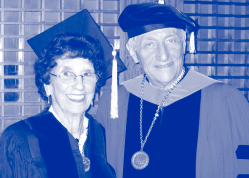
Words proudly expressed in a news release written by colleague Eva Cohen, "It is with profound pride and deep affection that NAVH's Board of Directors and Staff share with the low vision community, and all our friends and supporters, the news of this most distinguished tribute, which represents much deserved acknowledgment of Dr. Marchi's life affirming work to benefit the "hard of seeing."
The presentation reads, in part:
"...For nearly half a century, you have brought hope and joy to countless men, women and children impaired by poor or failing sight. In that time, the organizations you founded, first the Committee to Aid Visually Handicapped Children and subsequently, the National Association for Visually Handicapped, (NAVH) have labored mightily to enrich the lives of the visually impaired.
Inspired by your courage, determination and vision, practitioners, educators, health professionals and lay people of both organizations have worked to serve and to better the lives of one of the largest groups of disabled people in the country: the partially sighted. As the current Chief Executive Officer of NAVH, you continue to imbue your original vision with impetus and renewed vitality. Born from personal experience and the discovery that adequate educational materials were not available to the partially sighted child, your efforts, nearly 50 years ago, initiated the transcription and publication of large printed books...instruments fundamental to fostering the independence of partially-sighted individuals. Your courage and your vision have been widely recognized. You have been named [a] Woman of the Year...In 1960 Gov. Edmund G. Brown appointed you a trustee of the Langley Porter Neuropsychiatric Institute of the University of California at San Francisco where you continued to serve three terms. You have been honored by leading professional organizations and learned societies. Recognizing the nobility of your vision and the excellence of your accomplishments, State University of New York proudly confers you the degree, Doctor of Humane Letters... June 2, 2002."
Dr. Alden Haffner, president of SUNY College of Optometry, nominated Ms. Marchi for this degree.
Low Vision Materials Available in Spanish

The population of older adults who are experiencing vision problems is growing dramatically. Many older people accept vision problems as a part of the aging process and, in many instances, do not see their eye care professional or seek assistance from community resources.
To reach the aging Hispanic population, a poster, health fair card, and a booklet entitled What You Should Know About Low Vision are now available in Spanish.
For copies of these materials, please contact:
Judy Scott, Director
American Foundation for the Blind Southwest
260 Treadway Plaza
Dallas, TX 75235
E-mail: jscott@afb.net
Telephone: 214-352-7222
Fax: 214-352-3214
Free Eye Healthcare Service Delivered by ChildSight®'s Mobile EyeCare Unit
Native American children responded enthusiastically to the colorful ChildSight® Mobile EyeCare Unit when it stopped at the Southern California Indian Center (SCIC)! The Unit, a bus converted and fully equipped as an ophthalmic clinic, sought to provide services for urban Native Americans, gain a "snapshot" impression of the prevalence of refractive error among them and test the advantages of service delivery by means of the recently acquired Unit.

The partnership of SCIC and ChildSight®, a division of Helen Keller Worldwide, contributed to ensure a culturally sensitive event that was welcomed by families with tribal affiliations ranging from the Alaskan Thlingit people to the Cheyenne and Cherokee. SCIC had laid the groundwork by contacting local Native American families about the opportunity for vision assessment. As a result, 106 children participated in a process of "self-referral"--that is, having some awareness of the importance of vision screening (or perhaps already aware of a visual defect), they took advantage of the opportunity to seek a professional evaluation and intervention. In all, over 30 tribes were represented.
A tent set up immediately outside the bus provided the vision screening site where four local optometrists, one staffing each of four lanes, met the children and conducted the screening. Among the 106 children who participated, an alarming 51 percent (54 children) failed with vision worse than 20/40-2. Seven children among that number were found to have the involvement of other eye pathologies and "boarded the bus" for further diagnosis by pediatric ophthalmologist Dr. Yadavinder Dang. Dr. Dang practices at Martin Luther King/Drew Medical Center and works regularly with the ChildSight® team in the Los Angeles area. With the fully equipped clinic available on the Mobile EyeCare Unit, Dr. Dang was able to treat five of the seven children. Two of the seven children were diagnosed with strabismus and given appointments with Dr. Dang at the MLK/Drew Medical Center.
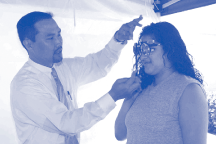
The attending optometrists prescribed lenses for those children whose only need was correction of refractive error and for four children who already had eyeglasses provided by their parents but needed updated prescriptions. A total of 45 children received prescription eyeglasses. Most of them received their eyeglasses immediately from inventory carried on the Unit and assembled at the site. All costs for screening, refraction, and eyeglasses were covered by the ChildSight® program. Fifteen of the older adolescent children elected to wait an extra day in order to receive free eyeglasses that they deemed more fashionable with greater variations in frame styles. Ordinarily, ChildSight® provides round "Harry Potter" style glasses from its existing inventory; however, teenagers have demonstrated improved retention and use of their glasses if their fashion sense is given consideration.
Under the leadership of HKW Vice President Meredith Tilp, ChildSight® works in schools where high populations of children living in poverty are enrolled. The program, introduced in 1994 in New York City, now serves in nine states and 16 major cities. More than 466,000 children have received vision screenings nationwide and 58,864 prescription eyeglasses have been dispensed as of June 2002. The pilot project that inspired the program's development was conducted in the Washington Heights District of New York City and is described in the December 1988 issue of The Journal of the American Association for Pediatric Ophthalmology and Strabismus.

The Mobile EyeCare Unit is a recent donation by eyeglass.com and makes possible ChildSight®'s new service to rural populations. The Native American event held at SCIC and similar events at Ramona Gardens Public Housing Project and in the Kern Valley of California have allowed the agency to test the utility and efficiency of the Mobile EyeCare Unit. Early in the coming year, the Unit will travel to several sites in California, including migrant labor camps, and then begin a three-stage journey across the United States. It will be based for a year in the Southwest, ranging out to Native American reservations to provide eyecare services and establish a rural clinic before moving on. Also on the itinerary is a year in the deep South and another in Appalachia, each geographic area to be served initially by the Unit but also to be left with ongoing service by local personnel hired and trained to staff rural clinics. ChildSight® is thus fulfilling its mission of service to people living in urban and rural poverty.
One can imagine the struggle to perform adequately in school under the handicap of blurred or distorted vision. ChildSight® considers relief from visual impairment not only as a contribution to good health but also a contribution to achieving one's academic, economic, and social potential throughout life.
For more information, please contact:
Caryl Chambers at 212-532-0544, ext. 829
or cchambers@childsight.org.
Nationwide Consortium Efforts
A Healthy Vision Consortium has been established to assist the professional, voluntary, and business sectors in achieving the vision objectives.

The Consortium represents a unified commitment for vision organizations and individuals to work together for a common goal: ensuring that vision information reaches every community nationwide. A wide range of individuals and groups concerned about eye health are joining the Consortium, promising to do their part in ensuring that the vision objectives in Healthy People 2010 are met. Consortium members agree to incorporate the vision objectives into their organization's strategies and programs, and report their organization's activities to the Healthy Vision Work Group, a cross section of vision representatives whose leadership has helped guide the development of the vision focus area. As a benefit for joining the Consortium, members have access to a Listserv where members can share resources, seek advice on conducting vision-related programs, and submit and receive news and announcements directly related to Healthy People 2010 activities.
Consortium members receive up-to-date information pertaining to Healthy Vision. Don't be left out!
For more information about the Healthy Vision Consortium and how to join, visit the Healthy Vision Website at www.healthyvision2010.org.
Watch for Healthy Vision Month in May 2003
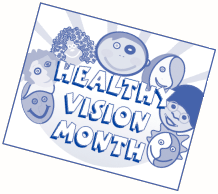
Beginning in May 2003, the National Eye Institute, one of the Federal government's National Institutes of Health, will sponsor Healthy Vision Month. Each year, Healthy Vision Month will focus on a different Healthy People 2010 vision objective. The focus for May 2003 will be objective 28-4, reduce blindness and visual impairment in children and adolescents.
Take the lead in your community to increase awareness of the importance of protecting and preserving vision in children and adolescents.
For educational materials and further information go to: http://www.healthyvision2010.org/hvm2003



